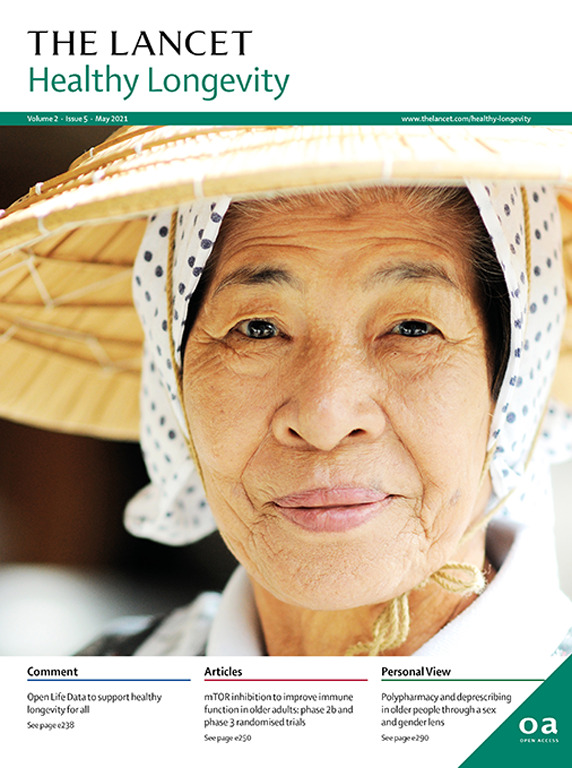健康的社会决定因素与 2 型糖尿病患者的预期寿命和未来健康风险的关系:英国和美国的两项全国性队列研究。
摘要
背景:健康的社会决定因素(SDHs)是造成可预防的健康不平等的主要驱动因素,SDHs 与 2 型糖尿病患者的健康结果之间的关系仍不清楚。本研究旨在估算英国和美国 2 型糖尿病成人患者的综合 SDHs 与预期寿命和未来健康风险之间的关系:在对两项全国性队列研究进行的分析中,从 2006 年 3 月 13 日至 2010 年 10 月 1 日的英国生物库(37-73 岁的成年人)和 1999 年至 2018 年的美国国家健康与营养调查(NHANES)(≥20 岁的成年人)中确定了 2 型糖尿病成年人。基线时患有 2 型糖尿病的参与者被纳入我们的分析。没有 SDHs 或随访信息的参与者被排除在外。英国生物库评估了17项SDHs,美国NHANES评估了10项SDHs,每项SDHs均分为优势水平和劣势水平。SDHs 的综合得分按每项 SDH 的加权得分之和计算。然后将参与者分为三等分(SDH 有利组、中等组和不利组)。主要结果是两个队列的预期寿命和死亡率,以及英国生物库中心血管疾病、糖尿病相关微血管疾病、痴呆症和癌症的发病率。英国生物库和美国NHANES队列的研究结果分别来自截至2021年12月31日和2019年12月31日的疾病登记:我们在分析中纳入了英国生物库队列中的 17 321 名参与者(中位数年龄 61-0 岁 [IQR 56-0-65-0]; 6028 [34-8%] 女性和 11 293 [65-2%] 男性)和 NHANES 队列中的 7 885 名参与者(平均年龄 59-2 岁 [95% CI 58-7-59-6]; 3835 [49-1%, 加权] 女性和 4050 [50-9%, 加权] 男性)。英国生物库记录了 3235 例死亡病例(中位数随访 12-3 年 [IQR 11-5-13-2])、3010 例心血管疾病病例(12-1 年 [10-8-13-0])、1997 例糖尿病相关微血管疾病病例(8-0 年 [7-1-8-9])、773 例痴呆病例(12-6 年 [11-8-13-5])和 2259 例癌症病例(11-3 年 [10-4-12-2]);美国 NHANES 记录了 2278 例死亡病例,中位数随访 7-0 年 (3-7-11-2)。经过多变量调整后,在英国生物库队列中,与SDH良好组相比,SDH中等组的危险比为1-33(95% CI 1-21-1-46),SDH不良组的危险比为1-89(1-72-2-07);在美国 NHANES 队列中,在全因死亡率方面,中等 SDH 组为 1-51(1-34-1-70),不利 SDH 组为 2-02(1-75-2-33);在心血管疾病发病率方面,中等 SDH 组为 1-13(1-04-1-24),不利 SDH 组为 1-40(1-27-1-53);在糖尿病相关微血管疾病方面,中等SDH组为1-13(1-01-1-27),不利SDH组为1-41(1-26-1-59);在痴呆症方面,中等SDH组为1-35(1-11-1-64),不利SDH组为1-76(1-46-2-13);在英国生物库队列中,中等SDH组癌症发病率为1-02(0-92-1-13),不利SDH组癌症发病率为1-17(1-05-1-30)(ptrend解释:综合不利的 SDH 与 2 型糖尿病成人患者预期寿命的延长和未来出现不良健康后果的风险增加有关。这些关联在来自不同社会背景的两个全国性队列中相似,在具有不同人口、生活方式和临床特征的人群中也基本一致。因此,评估2型糖尿病患者的综合SDHs可能是一种很有前景的方法,可将其纳入糖尿病护理中,以识别社会弱势群体并减轻疾病负担:国家自然科学基金、国家重点研发计划、中央高校基本科研业务费。Background
Social determinants of health (SDHs) are the primary drivers of preventable health inequities, and the associations between SDHs and health outcomes among individuals with type 2 diabetes remain unclear. This study aimed to estimate the associations of combined SDHs with life expectancy and future health risks among adults with type 2 diabetes from the UK and USA.
Methods
In an analysis of two nationwide cohort studies, adults with type 2 diabetes were identified from the UK Biobank from March 13, 2006, to Oct 1, 2010 (adults aged 37–73 years) and the US National Health and Nutrition Examination Survey (NHANES) from 1999 to 2018 (adults aged ≥20 years). Participants with type 2 diabetes at baseline were included in our analysis. Participants without information on SDHs or follow-up were excluded. The UK Biobank assessed 17 SDHs and the US NHANES assessed ten SDHs, with each SDH dichotomised into advantaged and disadvantaged levels. The combined score of SDHs were calculated as the sum of the weighted scores for each SDH. Participants were then categorised into tertiles (favourable, medium, and unfavourable SDH groups). Primary outcomes were life expectancy and mortality in both cohorts, and incidences of cardiovascular disease, diabetes-related microvascular disease, dementia, and cancer in the UK Biobank. Outcomes were obtained from disease registries up until Dec 31, 2021, in the UK Biobank and Dec 31, 2019, in the US NHANES cohorts.
Findings
We included 17 321 participants from the UK Biobank cohort (median age 61·0 years [IQR 56·0–65·0]; 6028 [34·8%] women and 11 293 [65·2%] men) and 7885 participants from the NHANES cohort (mean age 59·2 years [95% CI 58·7–59·6]; 3835 [49·1%, weighted] women and 4050 [50·9%, weighted] men) in our analysis. In the UK Biobank, 3235 deaths (median follow-up 12·3 years [IQR 11·5–13·2]), 3010 incident cardiovascular disease (12·1 years [10·8–13·0]), 1997 diabetes-related microvascular disease (8·0 years [7·1–8·9]), 773 dementia (12·6 years [11·8–13·5]), and 2259 cancer cases (11·3 years [10·4–12·2]) were documented; and the US NHANES documented 2278 deaths during a median follow-up of 7·0 years (3·7–11·2). After multivariable adjustment, compared with the favourable SDH group, the hazard ratio was 1·33 (95% CI 1·21–1·46) in the medium SDH group and 1·89 (1·72–2·07) in the unfavourable SDH group in the UK Biobank cohort; 1·51 (1·34–1·70) in the medium SDH group and 2·02 (1·75–2·33) in the unfavourable SDH group in the US NHANES cohort for all-cause mortality; 1·13 (1·04–1·24) in the medium SDH group and 1·40 (1·27–1·53) in the unfavourable SDH group for incident cardiovascular disease; 1·13 (1·01–1·27) in the medium SDH group and 1·41 (1·26–1·59) in the unfavourable SDH group for incident diabetes-related microvascular disease; 1·35 (1·11–1·64) in the medium SDH group and 1·76 (1·46–2·13) in the unfavourable SDH group for incident dementia; and 1·02 (0·92–1·13) in the medium SDH group and 1·17 (1·05–1·30) in the unfavourable SDH group for incident cancer in the UK Biobank cohort (ptrend<0·010 for each category). At the age of 45 years, the mean life expectancy of participants was 1·6 years (0·6–2·3) shorter in the medium SDH group and 4·4 years (3·3–5·4) shorter in the unfavourable SDH group than in the favourable SDH group in the UK Biobank. In the US NHAHES cohort, the life expectancy was 1·7 years (0·6–2·7) shorter in the medium SDH group and 3·0 years (1·8–4·3) shorter in the unfavourable SDH group, compared with the favourable group.
Interpretation
Combined unfavourable SDHs were associated with a greater loss of life expectancy and higher risks of developing future adverse health outcomes among adults with type 2 diabetes. These associations were similar across two nationwide cohorts from varied social contexts, and were largely consistent across populations with different demographic, lifestyle, and clinical features. Thus, assessing the combined SDHs of individuals with type 2 diabetes might be a promising approach to incorporate into diabetes care to identify socially vulnerable groups and reduce disease burden.
Funding
The National Natural Science Foundation of China, the National Key R&D Program of China, and the Fundamental Research Funds for the Central Universities.

 求助内容:
求助内容: 应助结果提醒方式:
应助结果提醒方式:


